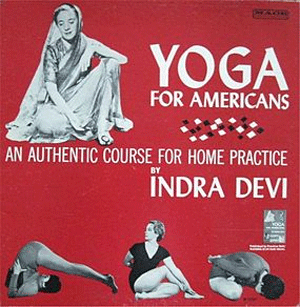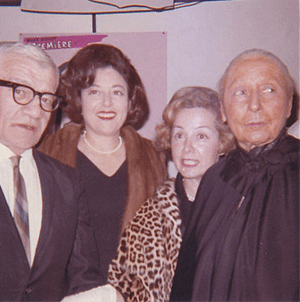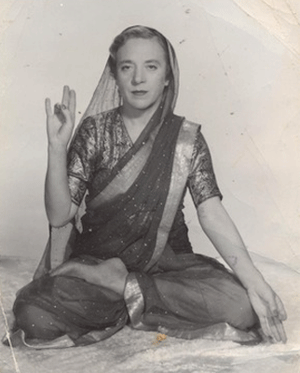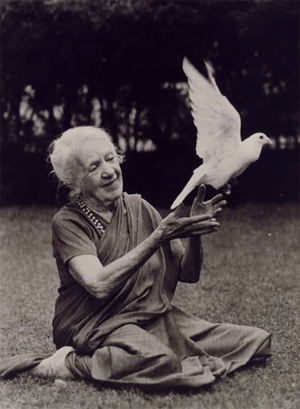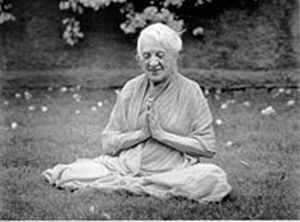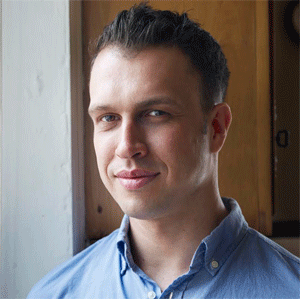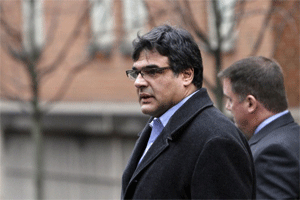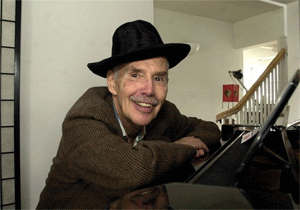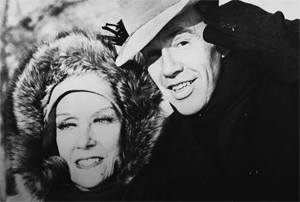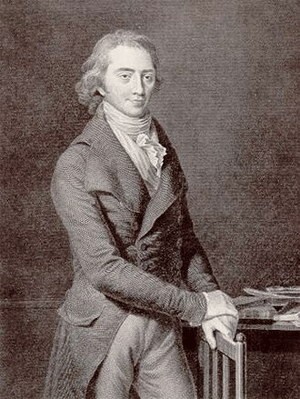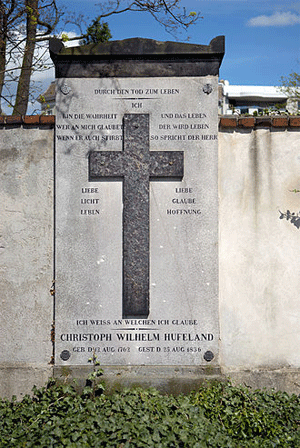by Wikipedia
Accessed: 6/22/19
NOTICE: THIS WORK MAY BE PROTECTED BY COPYRIGHT
YOU ARE REQUIRED TO READ THE COPYRIGHT NOTICE AT THIS LINK BEFORE YOU READ THE FOLLOWING WORK, THAT IS AVAILABLE SOLELY FOR PRIVATE STUDY, SCHOLARSHIP OR RESEARCH PURSUANT TO 17 U.S.C. SECTION 107 AND 108. IN THE EVENT THAT THE LIBRARY DETERMINES THAT UNLAWFUL COPYING OF THIS WORK HAS OCCURRED, THE LIBRARY HAS THE RIGHT TO BLOCK THE I.P. ADDRESS AT WHICH THE UNLAWFUL COPYING APPEARED TO HAVE OCCURRED. THANK YOU FOR RESPECTING THE RIGHTS OF COPYRIGHT OWNERS.
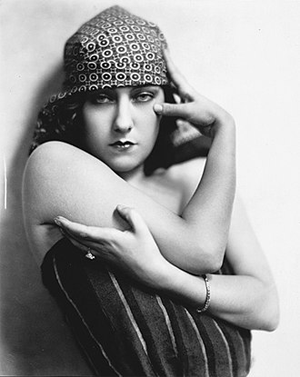
Gloria Swanson
Swanson in 1922
Born Gloria May Josephine Swanson[1]
March 27, 1899
Chicago, Illinois, U.S.
Died April 4, 1983 (aged 84)
New York City, U.S.
Resting place Church of the Heavenly Rest, New York City
Other names Gloria Mae
Education Hawthorne Scholastic Academy
Occupation Actress, producer
Years active 1914–1983
Height 4 ft 11 in (150 cm)
Spouse(s) Wallace Beery
(m. 1916; div. 1918)
Herbert K. Somborn
(m. 1919; div. 1925)
Henry de La Falaise
(m. 1925; div. 1930)
Michael Farmer
(m. 1931; div. 1934)
William Davey
(m. 1945; div. 1946)
William Dufty
(m. 1976)
Children 3
Gloria May Josephine Swanson (March 27, 1899 – April 4, 1983) was an American actress and producer. She achieved widespread critical acclaim and recognition for her role as Norma Desmond, a reclusive silent film star, in the critically acclaimed 1950 film Sunset Boulevard. The film earned her an Academy Award nomination and a Golden Globe Award win.
Swanson was also a star in the silent film era as both an actress and a fashion icon, especially under the direction of Cecil B. DeMille. Throughout the 1920s, Swanson was one of Hollywood's top box office draws.[2]
Swanson starred in dozens of silent films, and was nominated for the first Academy Award for Best Actress. She also produced her own films during this period, including The Love of Sunya (1927) and Sadie Thompson (1928). In 1929, Swanson transitioned into talkies with her performance in The Trespasser. Personal problems and changing tastes saw her popularity wane during the 1930s and she subsequently ventured into theater and television.
Early life
Gloria May Josephine Swanson[1] was born in a small house in Chicago in 1899, the only child to Adelaide (née Klanowski) and Joseph Theodore Swanson, a soldier. She attended Hawthorne Scholastic Academy. Her father was from a strict Lutheran Swedish American family, and her mother was of German, French, and Polish ancestry.[3][4]
Because of her father's attachment to the U.S. Army, the family moved frequently and Swanson ended up spending most of her childhood in Puerto Rico, where she learned Spanish. She also spent time in Key West, Florida. It was not her intention to enter show business, but at 15, on a whim one of her aunts took her to a small film company in Chicago called Essanay Studios for a visit and Swanson was asked to come back to work as an extra.[5]
After a few months as an extra working with others like Charlie Chaplin, and making $13.50 a week, Swanson left school to work full-time at the studio. Her parents soon separated and she and her mother moved to California.[6]
Career
Early years
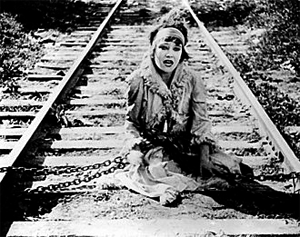
Gloria Swanson in Teddy at the Throttle (1917).
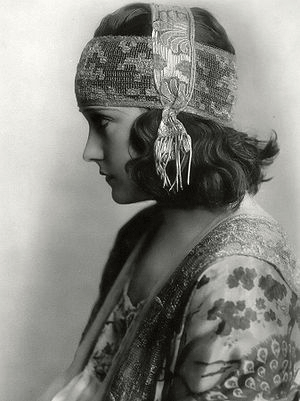
Gloria Swanson in a production still from the film, Don't Change Your Husband (1919).
Swanson made her film debut in 1914 as an extra in The Song of Soul for Essanay. She subsequently moved to California in 1916 to appear in Mack Sennett's Keystone Studios comedies opposite Bobby Vernon. With their great screen chemistry, the pair became popular. Director Charley Chase recalled that she was "frightened to death" of Vernon's dangerous stunts. Conquering her fears, however, she often cooperated with Vernon.[7] Surviving films in which they appear together include The Danger Girl (1916), The Sultan's Wife (1917), and Teddy at the Throttle (1917).
In 1919 she signed with Paramount Pictures and worked often with Cecil B. DeMille, who turned her into a romantic lead in such films as Don't Change Your Husband (1919), Male and Female (1919) with the famous scene posing as "the Lion's Bride" with a real lion, Why Change Your Wife? (1920), Something to Think About (1920), and The Affairs of Anatol (1921).
In the space of two years, Swanson rocketed to stardom and was one of the most sought-after actresses in Hollywood. She later appeared in a series of films directed by Sam Wood. She starred in Beyond the Rocks (1922) with her longtime friend Rudolph Valentino. (Long believed to be a lost film, Beyond the Rocks was rediscovered in 2004 in a private collection in The Netherlands and is now available on DVD.) Swanson continued to make costume drama films for the next few years. So successful were her films for Paramount that the studio was afraid of losing her and gave in to many of her whims and wishes.[8]
During Swanson's heyday, audiences went to her films not only for her performances, but also to see her wardrobe. She was frequently ornamented with beads, jewels, peacock and ostrich feathers and other extravagant pieces of haute couture. Her fashion, hair styles, and jewels were copied around the world. She was the screen's first clothes horse and was becoming one of the most famous and photographed women in the world.[9]
In 1925, Swanson starred in the French-American Madame Sans-Gêne, directed by Léonce Perret. Filming was allowed for the first time at many of the historic sites relating to Napoleon. While it was well received at the time, no prints are known to exist, and it is considered to be a lost film. During the production of Madame Sans-Gêne, Swanson met her third husband Henri, Marquis de la Falaise, who had been hired to be her translator during the film's production. After a four-month residency in France she returned to the United States as European nobility, now known as the Marquise. She got a huge welcome home with parades in both New York and Los Angeles. Swanson appeared in a 1925 short produced by Lee DeForest in his Phonofilm sound-on-film process. She made a number of films for Paramount, among them The Coast of Folly, Stage Struck and Fine Manners.[citation needed]
In 1927, she decided to turn down a one-million-dollar-a-year (equivalent to $14,400,000 in 2018) contract with Paramount to join the newly created United Artists, where she was her own boss and could make the films she wanted, with whom she wanted, and when. Her first independent film, The Love of Sunya, was directed by Albert Parker, based on the play The Eyes of Youth, by Max Marcin and Charles Guernon. Produced by and starring Swanson, it co-starred John Boles and Pauline Garon. It is the story of a young woman granted the ability to see into her future, including her future with different men. The story had been filmed previously as Eyes of Youth starring Clara Kimball Young (that production was also directed by Albert Parker and was responsible for the discovery of Rudolph Valentino by June Mathis). The production was marred by several problems, mainly a suitable cameraman to deal with the film's intricate double exposures, as Swanson was not used to taking charge, and filming took place in New York. The film premiered at the grand opening of the Roxy Theatre in New York City on March 11, 1927. (Swanson was pictured in the ruins of the Roxy on October 14, 1960, during the demolition of the theater, in a famous photo taken by Time-Life photographer Eliot Elisofon and published in Life magazine.) The production had been a disaster and Swanson felt its success would be mediocre at best.[10] On the advice of Joseph Schenck, Swanson returned to Hollywood, where Schenck begged her to film something more commercial. She agreed but ended up filming the more controversial Sadie Thompson instead.[10]
Sadie Thompson
Main article: Sadie Thompson
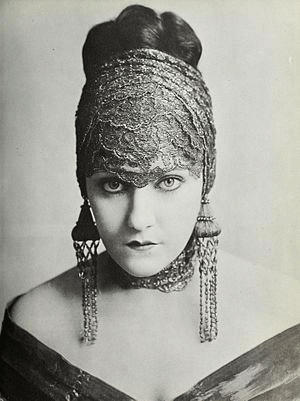
A 1919 portrait of Swanson.
Feeling she would never have as much artistic freedom and independence as she had at that moment, Swanson decided she "wanted to make [her] Gold Rush".[11] Schenck pleaded with her to do a commercially successful film like The Last of Mrs. Cheyney. Swanson felt it was too formulaic, and decided to call on director Raoul Walsh, who was signed with Fox Film Corporation at the time.[12] Walsh had been known for bringing controversial material to film, and at their first meeting suggested the John Colton/Clemence Randolph play Rain (1923), based on a story by W. Somerset Maugham in 1921 titled Miss Thompson. She had seen Jeanne Eagels perform the role twice, and enjoyed it.[13]
Because of its content, producing the film under the tight restrictions of the Hays Code would be almost impossible. The play was on the unofficial blacklist, and had quietly been banned from film-making a year earlier.[14] To try to avoid issues with the code, Swanson and Walsh left out profanity, renamed "Reverend Davidson" "Mr. Davidson", and stated it was in the interest of morality to produce the picture as Irving Thalberg had produced The Scarlet Letter (1926) at MGM.[15]
Swanson invited Will Hays for lunch and summarized the plot, naming the author and the sticking points. According to Swanson, Hays made a verbal promise he would have no problem with the making of such a film.[16] Swanson set out to get the rights to the play by having Schenck pretend to buy it in the name of United Artists, never to be used.[17] They were able to obtain the story rights for $60,000 instead of the original $100,000. When news broke concerning just what was intended with the play, the three authors threatened to sue.[10][14] Swanson later contacted Maugham about rights to a sequel, and he offered to grant them for $25,000. Maugham claimed Fox had asked about a sequel at the same time Swanson had bought the original story's rights. The sequel was to follow the further exploits of Sadie in Australia, but was never made.[18]
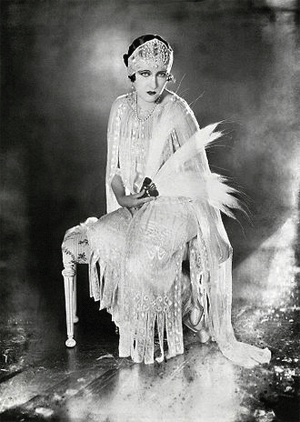
Swanson performing in 1922.
Swanson and Walsh set about writing the script,[19] and discreetly placed an ad announcing the film, thinking no one noticed, as Charles Lindbergh had just completed his historic transatlantic flight. However, the press picked up on it and sensationalized the story.[14] United Artists received a threatening two-page telegram from the MPAA signed by all its members, including Fox (Walsh's studio) and Hays himself. In addition, the rest of the signers owned several thousand movie houses, and if they refused to screen the film it could be a financial disaster.[20] This was the first time Swanson had heard the[clarification needed] name of Joseph P. Kennedy, with whom she later had an affair, and who arranged financing for her next few pictures, including Queen Kelly (1929).[21]
Swanson was angered by the response, as she felt those very studios had produced questionable films themselves, and were jealous at not having the chance to produce Rain.[22] After another threatening telegram, she decided to first appeal to the MPAA, and then the newspapers.[23] She heard back only from Marcus Loew, who promised to appeal on her behalf, and since he owned a chain of theaters this eased some of her concerns. Figuring the silence meant the matter had been dropped, Swanson began filming on Sadie Thompson which already had $250,000 invested in it.[24] Before casting began, the young Douglas Fairbanks, Jr. wanted to audition for the role of Handsome O'Hara.[22] However, Swanson felt he was too young and not right for the role.[25] Lionel Barrymore had been first picked to play Davidson but was thought to be too ill at the time, though he eventually won the role.[25] Barrymore wore the same outfit for an entire week, aggravating Swanson. She asked some of the crew to tell him to change and wash, which he did.[26] Aside from this, Swanson was happy with his performance. Walsh had not appeared in front of a camera in eight years, and feared he would not be able to direct and act at the same time. However, two days into filming, his fears had disappeared.[27]
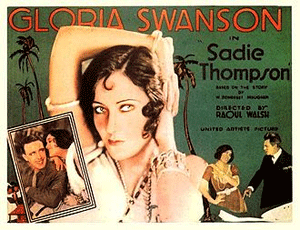
Swanson depicted on a Sadie Thompson lobby card (1928).
Much of the filming took place on Santa Catalina Island near Long Beach, California. Swanson took ill shortly after, and met a doctor who started her lifelong love of macrobiotic diets.[28] A week into shooting, Sam Goldwyn called cameraman George Barnes away. Swanson was furious, but the loan contract had allowed Goldwyn to call him away as he pleased.[29] Not wanting to let a hundred extras sit around for days, Swanson and Walsh tried to hire two more cameramen, but both were unsatisfactory. Mary Pickford had offered the services of her favorite cameraman Charles Rosher, who was called in but despite doing a decent job couldn't match Barnes' work.[30] Swanson, remembering the kindness showed by Marcus Loew during the telegram affair, turned to him again, desperate for help. Although Loew was sick and would soon die, he told MGM to give her anyone she wanted. MGM loaned her Oliver Marsh and he completed the picture.[31]
The cameraman fiasco was extremely costly to the production, yet shooting continued. With the picture half finished, it was already well over budget, and Schenck was wary, as Swanson's first picture had also been over budget and underperformed. Swanson talked with her advisers and sold her home in Croton-on-Hudson, New York, and offered to sell her New York City penthouse as well.[31]
Despite reports that "dirty" words can be read on the characters' lips, Swanson said the censors went over everything with a fine-tooth comb.[32] However, Swanson admitted that one line she was shouting at Davidson went, "You'd rip the wings off of a butterfly, you son of a bitch!" when recounting a conversation with Walsh later in life.[33] If the word rain was used in a title, they asked that it be removed. They also wanted to change Davidson's name to something else, but Swanson and Walsh refused.[32]
The film was a success and was the only silent independent film of Swanson's to do well at the box office. It was one of her last financially successful films, including the talkies The Trespasser and Sunset Blvd.[34] It went on to make $1,000,000 during its US run. However, at Kennedy's advice, Swanson had sold her distribution rights for the film to Schenck, as Kennedy felt it would be a commercial failure.[35] He also didn't care for the image Swanson portrayed in the film. By this point, Queen Kelly had been a disaster, and Swanson regretted it.[35] The film made the top ten best pictures of the year list as well. It was Raoul Walsh's final role, as he subsequently lost an eye in an accident. The film was nominated for awards for Best Actress in a Leading Role (Gloria Swanson) and Best Cinematography. Swanson did not attend the ceremony, and always felt it was like "comparing apples to oranges".[35] Contemporary reviews called it racy but excellent, and praised Swanson's performance.[36] At present, the film, save for the final reel (stopping just after Davidson finds Sadie in his room), exists in good condition.
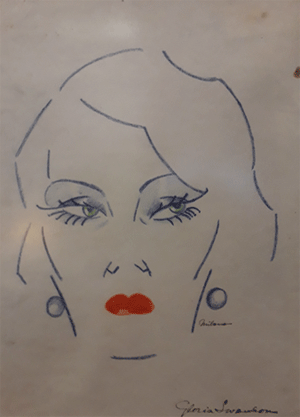
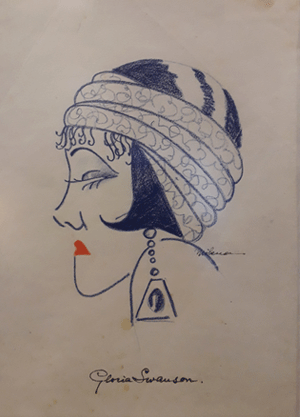
Drawings of Gloria Swanson by Milena Pavlović-Barili, the most notable female artist of Serbian modernism.
Queen Kelly
One of the best known of Hollywood's unfinished films, Queen Kelly (1929), was directed by Erich von Stroheim and produced by Joseph P. Kennedy, Sr., father of the future President John F. Kennedy. Produced in 1928–29, the film starred Swanson in the title role, with Walter Byron and Seena Owen. It is the story of Prince Wolfram, betrothed to the mad Queen Regina V of Kronberg. On maneuvers (as punishment for consorting with other women), he spies Kelly walking with the other students of a convent. Enthralled by her beauty, he kidnaps her that night from the convent, takes her to his room and professes his love for her. When the Queen finds them together the next morning, she whips Kelly and throws her out of the castle. Queen Regina then puts Wolfram in prison for his refusal to marry her. Kelly goes to German East Africa to visit her dying Aunt, and is forced to marry the disgusting Jan. The Aunt dies after the wedding, and Kelly refuses to live with Jan, becoming the head of her aunt's brothel. Her extravagances and style earn her the name Queen Kelly.[37]
Production of the costly film was shut down after complaints by Swanson about von Stroheim and the general direction the film was taking. Though the European scenes were full of innuendo, and featured a philandering prince and a sex-crazed queen, the scenes set in Africa were grim and, Swanson felt, distasteful. In later interviews, Swanson said that she had been misled by the script, which referred to her character arriving in, and taking over, a dance hall; looking at the rushes, it was obvious the "dance hall" was actually a brothel.[38]
Stroheim was fired from the film, and the African story line was scrapped. Swanson and Kennedy still wanted to salvage the European material, as it had been so costly and time-consuming, and had potential market value. An alternative ending was shot on November 24, 1931.[39] In this ending, directed by Swanson and photographed by Gregg Toland, Prince Wolfram is shown visiting the palace. A nun leads him to the chapel, where Kelly's body lies in state. This has been called the "Swanson ending". The film was not theatrically released in the United States, but it was shown in Europe and South America with the Swanson ending tacked on. This was due to a clause in Stroheim's contract.[40]
A short extract of the film appears in Sunset Boulevard (1950), representing an old silent picture Swanson's character Norma Desmond—herself a silent movie star—had made. Von Stroheim is also a primary character in Sunset Boulevard as her ex-director, ex-husband, and current butler. In the 1960s, it was shown on television with the Swanson ending, along with a taped introduction and conclusion in which Swanson spoke about the history of the project. By 1985, Kino International had acquired the rights to the movie and restored two versions: one that uses still photos and subtitles in an attempt to wrap up the storyline, and the other the European "suicide ending" version.[citation needed]
Sound era
On March 29, 1928, at the bungalow of Mary Pickford at United Artists, Swanson, Pickford, Douglas Fairbanks, Charles Chaplin, Norma Talmadge, John Barrymore, Dolores del Río and D. W. Griffith met to speak on the radio show, The Dodge Brothers Hour, to prove they could meet the challenge of talking movies.[41] To try to recover from the Queen Kelly fiasco, Swanson jumped into making talkies, including The Trespasser (1929), What a Widow! (1930), Indiscreet (1931), Perfect Understanding (1933), and Music in the Air (1934).
The Trespasser tells the story of a "kept woman" who maintains a lavish lifestyle. The film stars Swanson, Robert Ames, Purnell Pratt, Henry B. Walthall, and Wally Albright. The movie was written and directed by Edmund Goulding and released by United Artists, and earned Swanson an Academy Award nomination in her talkie debut. Swanson sang the song "Love, Your Magic Spell Is Everywhere" written by Goulding and Elsie Janis. The Trespasser was filmed simultaneously in a silent and a talking version, and was a smash hit.
The Trespasser was an important film for Swanson, following the disastrous Queen Kelly and the hit Sadie Thompson, and garnered Swanson her second Oscar nomination. Sadly for Swanson, The Trespasser proved to be one of her only two hit talkies, the other being Sunset Boulevard, made over 20 years later. Subsequent follow-ups like What a Widow!, Indiscreet, Tonight or Never, Perfect Understanding, and Music in the Air all proved to be box-office flops. Despite the disappointments following The Trespasser, Swanson was well remembered by Billy Wilder, a writer on Music in the Air, when he was casting the part of Norma Desmond in his masterpiece Sunset Boulevard (1950).
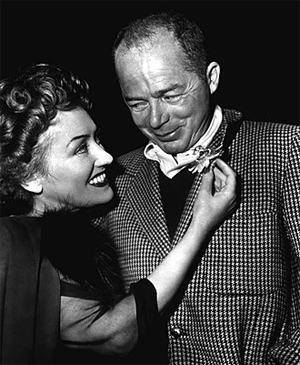
With director Billy Wilder during the filming of Sunset Boulevard.
Although she made the transition to talkies, as her film career began to decline, Swanson relocated permanently to New York City in 1938, where she began an inventions and patents company called Multiprises, which kept her occupied during the years of World War II. This small company had the sole purpose of rescuing Jewish scientists and inventors from war-torn Europe and bringing them to the United States. She helped many escape, and some useful inventions came from the enterprise.
Swanson made another film for RKO in 1941 (Father Takes a Wife), began appearing in the legitimate theater, and starred in her own television show in 1948. She threw herself into painting and sculpting, writing a syndicated column, touring in summer stock, engaging in political activism, radio and television work, clothing and accessories design and marketing, and making occasional appearances on the big screen. But it was not until 1950 when Sunset Boulevard was released (earning her yet another Academy Award nomination) that she achieved mass recognition again.[citation needed]
Sunset Boulevard
Main article: Sunset Boulevard (film)
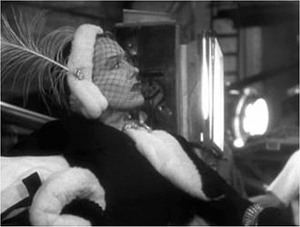
Gloria Swanson as Norma Desmond in Sunset Boulevard (1950).
After Mae West, Mary Pickford and Pola Negri all declined the role,[42] Swanson starred in 1950's Sunset Boulevard, portraying Norma Desmond, a faded silent movie star who falls in love with the younger screenwriter Joe Gillis, played by William Holden. Desmond lives in the past, assisted by her butler Max, played by Erich von Stroheim. Her dreams of a comeback are subverted as she becomes delusional. There are cameos from actors of the silent era in the film, including Buster Keaton, H. B. Warner and Anna Q. Nilsson. Cecil B. DeMille plays himself in a pivotal scene. Some of the lines from the film have become pop-culture mainstays, including "The Greatest Star of them all"; "I am big; it's the pictures that got small"; "We didn't need dialogue, we had faces"; and "All right, Mr. DeMille, I'm ready for my close-up." She received her third Best Actress Oscar nomination, but lost to Judy Holliday for Born Yesterday.[43]
Swanson received several subsequent acting offers but turned most of them down, saying they tended to be pale imitations of Norma Desmond. Her last major Hollywood motion picture role was the poorly received Three for Bedroom "C" in 1952.[44] In 1956, Swanson made Nero's Mistress, which also starred Alberto Sordi, Vittorio de Sica and Brigitte Bardot. Her final screen appearance was as herself in Airport 1975. Although Swanson only made three films after Sunset Boulevard, she starred in numerous stage and television productions during her remaining years. She was active in various business ventures, traveled extensively, wrote articles, columns, and an autobiography, painted and sculpted, and became a passionate advocate of various health and nutrition topics.
Television and theater
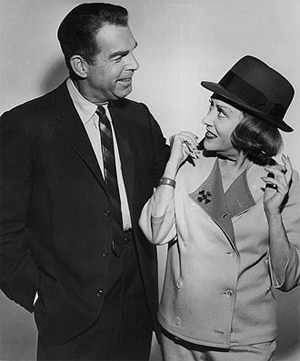
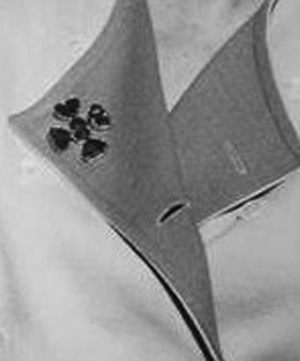
Swanson with Fred MacMurray in the promo of My Three Sons (1965).
Swanson hosted one of the first live television series in 1948, The Gloria Swanson Hour, in which she invited friends and others to be guests. Swanson also later hosted a television anthology series, Crown Theatre with Gloria Swanson, in which she occasionally acted.[45]
Through the 1960s, 1970s, and early 1980s, Swanson appeared on many different talk and variety shows such as The Carol Burnett Show in 1973 and The Tonight Show Starring Johnny Carson to recollect her films and to lampoon them as well. She was twice the "mystery guest" on What's My Line. She acted in "Behind the Locked Door" on The Alfred Hitchcock Hour in 1964, and in the same year was nominated for a Golden Globe award for her performance in Burke's Law. She made a guest appearance on The Dick Cavett Show in the summer of 1970; a guest on the same show as Janis Joplin, who died later that year.[46]
She made a notable appearance in a 1966 episode of The Beverly Hillbillies, called "The Gloria Swanson Story", in which she plays herself. In the episode, the Clampetts mistakenly believe Swanson is destitute, and decide to finance a comeback movie for her – in a silent film. Her last acting role, aside from playing herself in Airport 1975, was in the made-for-TV horror film Killer Bees (1974). After near-retirement from films, Swanson appeared in many plays throughout her later life, beginning in the 1940s. She toured with A Goose for the Gander, Reflected Glory, and Let Us Be Gay. After her success with Sunset Boulevard, she starred on Broadway in a revival of Twentieth Century (1951) with José Ferrer, and in Nina with David Niven. Her last major stage role was in the 1971 Broadway production of Butterflies Are Free at the Booth Theatre. Swanson appeared on The Carol Burnett Show in 1973, doing a sketch where she flirted with Lyle Waggoner. The episode was called "Carol and Sis/The Guilty Man."
In 1980, Swanson's autobiography, Swanson on Swanson, was published and became a commercial success. Kevin Brownlow and David Gill interviewed her for Hollywood (1980), a television history of the silent era.
Personal life
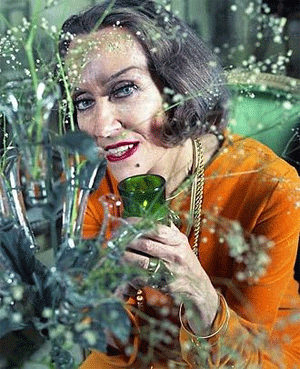
Swanson in her New York City apartment (1972).
Swanson became a vegetarian around 1928 and was an early health food advocate who was known for bringing her own meals to public functions in a paper bag. Swanson told actor Dirk Benedict about macrobiotic diets when he was battling prostate cancer at a very early age. He had refused conventional therapies and credited this kind of diet and healthy eating with his recovery.[47] In 1975, Swanson traveled the United States and helped to promote the book Sugar Blues written by her husband, William Dufty.
In early 1980, Swanson's 520-page autobiography, Swanson on Swanson, was published by Random House and became a national best-seller. It was translated into French, Italian and Swedish editions. That same year, she also designed a stamp cachet for the United Nations Postal Administration.
She was a pupil of the modern yoga guru Indra Devi, and was photographed performing a series of yoga poses, reportedly looking much younger than her age, for Devi to use in her book Forever Young, Forever Healthy; but the publisher Prentice-Hall decided to use the photographs for Swanson's book, not Devi's. In return, Swanson, who normally never did publicity events, helped to launch Devi's book at the Waldorf-Astoria in 1953.[48]
Religion
Swanson was a long-time member of the Lutheran church; her father was of Swedish Lutheran descent.[49] In 1964, Swanson spoke at a "Project Prayer" rally attended by 2,500 at the Shrine Auditorium in Los Angeles. The gathering, which was hosted by Anthony Eisley, a star of ABC's Hawaiian Eye series, sought to flood the United States Congress with letters in support of mandatory school prayer, following two decisions in 1962 and 1963 of the United States Supreme Court, which struck down mandatory prayer as conflicting with the Establishment Clause of the First Amendment to the United States Constitution.[50] Joining Swanson and Eisley at the Project Prayer rally were Walter Brennan, Lloyd Nolan, Rhonda Fleming, Pat Boone, and Dale Evans. Swanson declared, "Under God we became the freest, strongest, wealthiest nation on earth, should we change that?"[50]
Marriages and relationships
Throughout her life and her many marriages, Swanson was always known as Miss Swanson. Though she legally took the names of her husbands, her own personality and fame always overshadowed them[citation needed]. Her first husband was the actor Wallace Beery, whom she married on her 17th birthday on March 27, 1916. In her autobiography Swanson on Swanson, Swanson wrote that Beery raped her on their wedding night. She became pregnant by him in 1917. Not wanting her to have the child, she claims he tricked her into drinking a concoction that induced an abortion. They still worked together at Sennett but they separated in June 1917 and Swanson filed for divorce later that year, it was finalized in 1918.[51]
She married Herbert K. Somborn (1919–1925), then-president of Equity Pictures Corporation and later the owner of the Brown Derby restaurant, in 1919; they had a daughter, Gloria Swanson Somborn (October 7, 1920 – December 28, 2000).[52] Their divorce, finalized in January 1925, was sensational and led to Swanson having a "morals clause" added to her studio contract. Somborn accused her of adultery with thirteen men including Cecil B. DeMille, Rudolph Valentino and Marshall Neilan. During their divorce Swanson wanted another child, and in 1923 she adopted a baby boy, Sonny Smith (1922–1975), whom she renamed Joseph Patrick Swanson.[citation needed]
Swanson's third husband was the French aristocrat Henri, Marquis de la Falaise de la Coudraye, whom she married on January 28, 1925, after the Somborn divorce was finalized. Though Henri was a Marquis and the grandson of Richard and Martha Lucy Hennessy from the famous Hennessy Cognac family, he was not rich and had to work for a living.[53] He was originally hired to be her assistant and interpreter in France while she was filming Madame Sans-Gêne (1925). Swanson was the first film star to marry European nobility, and the marriage became a global sensation. She conceived a child with him, but had an abortion, which, in her autobiography, she said she regretted. Later, Henri became a film executive representing Pathé (USA) in France through Joseph P. Kennedy, Sr., who was running the studio. Many now assume he was given the position, which kept him in France for ten months a year, to simply keep him out of the way.[54] This marriage ended in divorce in 1930.[55]
While still married to Henri, Swanson had an affair with the married Joseph P. Kennedy, father of future President John F. Kennedy, for a number of years. He became her business partner and their relationship was an open secret in Hollywood. He took over all of her personal and business affairs and was supposed to make her millions. Unfortunately, Kennedy left her after the disastrous Queen Kelly and her finances were in worse shape than when he came into her life. Two books have been written about the affair.[56]
After the marriage to Henri and her affair with Kennedy were over, Swanson married Michael Farmer (1902–1975) in August 1931. Because of the possibility that Swanson's divorce from La Falaise had not been final at the time of the wedding, she was forced to remarry Farmer the following November, by which time she was four months pregnant with Michelle Bridget Farmer, who was born on April 5, 1932.[57] Swanson and Farmer divorced in 1934, after she became involved with married British actor Herbert Marshall. The media reported widely on her affair with Marshall.[58][59][60] After almost three years with the actor, Swanson left him once she realized he would never divorce his wife, Edna Best, for her.[61] In an early manuscript of her autobiography written in her own hand decades later, Swanson recalled, "I was never so convincingly and thoroughly loved as I was by Herbert Marshall."[62]
In 1945, Swanson married William N. Davey and according to her after discovering Davey in a drunken stupor, she and daughter Michelle, believing they were being helpful, left a trail of Alcoholics Anonymous literature around the apartment. Davey quickly packed up and left.[63] The Swanson-Davey divorce was finalized in 1946.[64] For the next thirty years Swanson would remain unmarried and able to pursue her own interests.
Swanson's final marriage occurred in 1976 and lasted until her death. Her sixth husband and widower, writer William Dufty (1916–2002), was the co-author of Billie Holiday's autobiography Lady Sings the Blues, the author of Sugar Blues, a 1975 best-selling health book still in print, and the author of the English version of Georges Ohsawa's You Are All Sanpaku. Dufty was a book ghost-writer and newspaperman, working for many years at the New York Post, where he was assistant to the editor from 1951 to 1960. He first met Swanson in 1965 and by 1967 the two were living together as a couple. Swanson shared her husband's deep enthusiasm for macrobiotic diets and they traveled widely together to speak about sugar and food. They promoted his book Sugar Blues together in 1975 and also wrote a syndicated column together.[65] It was through Sugar Blues that Dufty and Swanson first got to know John Lennon and Yoko Ono. Swanson testified on Lennon's behalf at his immigration hearing in New York, which led to him becoming a permanent resident.[66] Dufty ghost-wrote Swanson's best-selling 1980 autobiography, Swanson on Swanson,[67] based on her early, sometimes handwritten drafts and notes. She personally revised the manuscript several times.[68] They were prominent socialites, having many homes and living in many places, including New York City, Rome, Portugal, and Palm Springs, California. After Swanson's death Dufty returned to his former home in Birmingham, Michigan. He died of cancer in 2002.[67]
Political views
Swanson was a Republican and supported the 1940 and 1944 campaigns for president of Wendell Willkie, and the 1964 presidential campaign of Barry Goldwater.[69] In 1980, she chaired the New York chapter of Seniors for Reagan-Bush.[70]
Death
Shortly after returning to New York from her home in the Portuguese Riviera, on April 4, 1983, Swanson died in New York City in New York Hospital from a heart ailment, aged 84.[71][72] She was cremated and her ashes interred at the Episcopal Church of the Heavenly Rest on Fifth Avenue, in New York City, attended by only a small circle of family. The church was the same one where the funeral of Chester A Arthur took place.[73] Fellow silent star Jacqueline Logan, who co-starred with Swanson in a film, died on the same day.
After Swanson's death, there was a series of auctions from August to September 1983 at William Doyle Galleries in New York of the star's furniture and decorations, jewelry, clothing, and memorabilia from her personal life and career.
Legacy
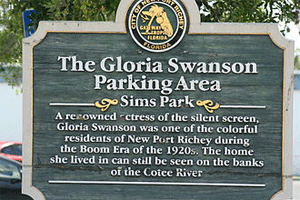
The Gloria Swanson parking lot in downtown New Port Richey, Florida honors the star.
In 1960, Gloria Swanson was honored with two stars on the Hollywood Walk of Fame: one for motion pictures at 6750 Hollywood Boulevard, and another for television at 6301 Hollywood Boulevard.[74] In 1955 and 1957, Swanson was awarded The George Eastman Award, given by George Eastman House for distinguished contribution to the art of film, and in 1966 the museum honored her with a career film retrospective, A Tribute to Gloria Swanson, which screened several of her films between May 12–18.[75] A parking lot by Sims Park in downtown New Port Richey, Florida, is named after the star, who is said to have owned property along the Cotee River.
In 1982, a year before her death, Swanson sold her archives of over 600 boxes for an undisclosed sum, including photographs, artwork, copies of films and private papers including correspondence, contracts and financial dealings to the Harry Ransom Center at the University of Texas at Austin.[76] The second-largest collection of Swanson materials is held in the family archives of Timothy A. Rooks. In the last years of her life Swanson professed a desire to see Beyond the Rocks, but the film was unavailable and considered lost. The film was rediscovered and screened in 2005.
As one of the greatest stars of early Hollywood, today, Swanson is most remembered for her portrayal of Norma Desmond in 1950's Sunset Boulevard.
Portrayals
Swanson has been played both on television and in film by the following actresses:
• 1977: Carol Burnett on The Carol Burnett Show
• 1984: Diane Venora in The Cotton Club
• 1990: Madolyn Smith in The Kennedys of Massachusetts
• 1991: Ann Turkel in White Hot: The Mysterious Murder of Thelma Todd
• 2008: Kristen Wiig in Saturday Night Live
• 2013: Debi Mazar in Return to Babylon
Filmography
Short subject
Year / Title / Role / Notes
1914 / The Song of the Soul / -- / Unconfirmed
1915 / The Misjudged Mr. Hartley / Maid / --
1915 / At the End of a Perfect Day / Hands Bouquet to Holmes / Uncredited
1915 / The Ambition of the Baron / Bit part / --
1915/ His New Job / Stenographer / Uncredited
1915 / The Fable of Elvira and Farina and the Meal Ticket / Farina, Elvira's Daughter / Credited as Gloria Mae
1915/ Sweedie Goes to College / College Girl / --
1915 / The Romance of an American Duchess / Minor Role / Uncredited
1915 / The Broken Pledge / Gloria / --
1916 / Sunshine / -- / --
1916 / A Dash of Courage / -- / --
1916 / Hearts and Sparks / -- / --
1916 / A Social Cub / -- / --
1916 / The Danger Girl / Reggie's madcap sister / --
1916 / Haystacks and Steeples / -- / --
1916 / The Nick of Time Baby / -- / --
1917 / Teddy at the Throttle / Gloria Dawn, His Sweetheart / --
1917 / Baseball Madness / -- / --
1917 / Dangers of a Bride / -- / --
1917 / Whose Baby? / -- / --
1917 / The Sultan's Wife / Gloria / --
1917 / The Pullman Bride / The Girl / --
1922 / A Trip to Paramountown / Herself / --
1925 / Gloria Swanson and Thomas Meighan / Herself / --
Features
Year / Title / Role / Notes
1918 / Society for Sale / Phylis Clyne / --
1918 / Her Decision / Phyllis Dunbar / Lost film
1918 / Station Content / Kitty Manning / --
1918 / You Can't Believe Everything / Patricia Reynolds / --
1918 / Everywoman's Husband / Edith Emerson / --
1918 / Shifting Sands / Marcia Grey / --
1918 / The Secret Code / Sally Carter Rand / Lost film
1918 / Wife or Country / Sylvia Hamilton / Lost film
1919 / Don't Change Your Husband / Leila Porter / --
1919 / For Better, for Worse / Sylvia Norcross / --
1919 / Male and Female / Lady Mary Lasenby / --
1920 / Why Change Your Wife? / Beth Gordon / --
1920 / Something to Think About / Ruth Anderson / --
1921 / The Great Moment / Nada Pelham/Nadine Pelham / Lost film
1921 / The Affairs of Anatol / Vivian Spencer – Anatol's Wife / --
1921 / Under the Lash / Deborah Krillet / Lost film
1921 / Don't Tell Everything / Marian Westover / Lost film
1922 / Her Husband's Trademark / Lois Miller / --
1922 / Her Gilded Cage / Suzanne Ornoff / Lost film
1922 / Beyond the Rocks / Theodora Fitzgerald / --
1922 / The Impossible Mrs. Bellew / Betty Bellew / Lost film
1922 / My American Wife / Natalie Chester / Lost film
1923 / Prodigal Daughters / Swifty Forbes / Lost film
1923 / Bluebeard's 8th Wife / Mona deBriac / Lost film
1923 / Hollywood / Cameo role / Lost film
1923 / Zaza / Zaza / --
1924 / The Humming Bird / Toinette / --
1924 / A Society Scandal / Marjorie Colbert / Lost film
1924 / Manhandled / Tessie McGuire / --
1924 / Her Love Story / Princess Marie / Lost film
1924 / Wages of Virtue / Carmelita / Lost film
1925 / Madame Sans-Gêne / Madame Sans-Gêne / Lost film
1925 / The Coast of Folly / Joyce Gathway/Nadine Gathway / Lost film
1925 / Stage Struck / Jennie Hagen / --
1926 / The Untamed Lady / St. Clair Van Tassel/ Lost film
1926 / Fine Manners / Orchid Murphy / --
1927 / The Love of Sunya / Sunya Ashling / Producer
1928 / Sadie Thompson / Sadie Thompson / Producer
1929 / Queen Kelly / Kitty Kelly/Queen Kelly / Producer
1929 / The Trespasser / Marion Donnell / --
1930 / What a Widow! / Tamarind Brook / Producer; lost film
1931 / Indiscreet / Geraldine "Gerry" Trent / --
1931 / Tonight or Never / Nella Vago / --
1933 / Perfect Understanding / Judy Rogers / Producer
1934 / Music in the Air / Frieda Hotzfelt / --
1941 / Father Takes a Wife / Leslie Collier Osborne / --
1950 / Sunset Boulevard / Norma Desmond / --
1952 / Three for Bedroom "C" / Ann Haven / Costume designer
1956 / Nero's Weekend / Agrippina / --
1972 / Chaplinesque, My Life and Hard Times / Narrator / --
1974 / Airport 1975 / Herself / --
Television
Year / Title / Role / Notes
1950 / The Peter Lind Hayes Show / -- / Episode #1.1
1953 / Hollywood Opening Night / -- / Episode: "The Pattern"
1954–1955 / Crown Theatre with Gloria Swanson / Hostess 2/ 5 episodes
1957 / The Steve Allen Show / Norma Desmond / Episode #3.8
1961 / Straightaway / Lorraine Carrington / Episode: "A Toast to Yesterday"
1963 / Dr. Kildare / Julia Colton / Episode: "The Good Luck Charm"
1963–1964 / Burke's Law / Various roles / 2 episodes
1964 / Kraft Suspense Theatre / Mrs. Charlotte Heaton / Segment: "Who Is Jennifer?"
1964 / The Alfred Hitchcock Hour / Mrs. Daniels / Episode: "Behind the Locked Door"
1965 / My Three Sons / Margaret McSterling / Episode: "The Fountain of Youth"
1965 / Ben Casey / Victoria Hoffman / Episode: "Minus That Rusty Old Hacksaw"
1966 / The Beverly Hillbillies / Herself / Episode: "The Gloria Swanson Story"
1973 / The Carol Burnett Show / Herself / Episode #7.3
1974 / Killer Bees / Madame Maria von Bohlen / Television movie
1980 / Hollywood / Herself / Television documentary
Awards and nominations
Year Award Result Category Film or series
1929 / Academy Award / Nominated / Best Actress / Sadie Thompson;
1930 / Academy Award / Nominated / Best Actress / The Trespasser
1951 / Academy Award / Nominated / Best Actress /Sunset Boulevard
1951 / Golden Globe Award / Won / Best Actress — Motion Picture Drama / Sunset Boulevard
1964 / Golden Globe Award / Nominated / Best TV Star – Female / Burke's Law
1951 / Italian National Syndicate of Film Journalists / Won / Best Actress – Foreign Film (Migliore Attrice Straniera) / Sunset Boulevard
1951 / Jussi Award / Won / Best Foreign Actress / Sunset Boulevard
1950 / National Board of Review of Motion Pictures / Won / Best Actress / Sunset Boulevard
1980 / National Board of Review of Motion Pictures / Won / Career Achievement Award / --
1975 / Saturn Award / Won / Special Award / --
-
See also
• List of actors with Academy Award nominations
• Biography portal
• Film portal
Notes
1. Cornell Sarvady, Andrea; Miller, Frank; Haskell, Molly; Osborne, Robert (2006). Leading Ladies: The 50 Most Unforgettable Actresses of the Studio Era. Chronicle Books. p. 185. ISBN 0-8118-5248-2.
2. Peter B. Flint, "Gloria Swanson Dies; 20s Film Idol, New York Times, Apr. 5, 1983, at D00027
3. Quirk, Lawrence J. (1984). The Films of Gloria Swanson. Citadel Press. p. 256. ISBN 0-8065-0874-4.
4. Harzig, Christiane (1996). Peasant Maids, City Women. Cornell University Press. p. 283. ISBN 0-8014-8395-6.
5. Swanson, Gloria (1981). Swanson on Swanson. Chapter 2: Random House. ISBN 0-394-50662-6.
6. Beauchamp, Cari (2009). Joseph P. Kennedy Presents. New York: Knopf. p. 108.
7. Shearer, Stephen Michael (August 27, 2013). Gloria Swanson: The Ultimate Star. United States: Thomas Dunne Books. p. 30. ISBN 978-1-250-00155-9.
8. Swanson 1981, see for example pp. 9, 93–95, 98, 131, 192
9. see Four Fabulous Faces: Swanson, Garbo, Crawford, Dietrichby Larry Carr, 1970, Galahad Books, ISBN 0-88365-044-4 and Without Lying Down: Frances Marion and the Powerful Women of Early Hollywood by Cari Beauchamp, University of California Press, 1998, ISBN 0-520-21492-7
10. Swanson 1981, p. 294
11. Swanson 1981, p. 295
12. Swanson 1981, pp. 295–296
13. Swanson 1981, p. 297
14. Swanson 1981, p. 305
15. Swanson 1981, pp. 297–302
16. Swanson 1981, p. 302
17. Swanson 1981, pp. 303–304
18. Swanson 1981, p. 323
19. Swanson 1981, p. 304
20. Swanson 1981, pp. 305–306
21. Swanson 1981, pp. 308–309
22. Swanson 1981, p. 307
23. Swanson 1981, p. 309
24. Swanson 1981, pp. 311–312
25. Swanson 1981, p. 313
26. Swanson 1981, pp. 320–321
27. Swanson 1981, pp. 317–318
28. Swanson 1981, pp. 313–317
29. Swanson 1981, pp. 319–320
30. Swanson 1981, p. 320
31. Swanson 1981, p. 321
32. Swanson 1981, p. 322
33. Swanson 1981, p. 499
34. Swanson 1981, p. 407
35. Swanson 1981, p. 374
36. Sadie Thompson review
37. Quirk, Lawrence (1984). The Films of Gloria Swanson. Citidal. pp. 211–214. ISBN 978-0-8065-0874-0.
38. Swanson 1981, pp. 388–392
39. Beauchamp, Cari (2009). Joseph P Kennedy Presents. Knopf. pp. 242–250, especially 247. ISBN 978-1-4000-4000-1.
40. SilentEra website
41. Ramon, David (1997). Dolores del Río. Clío. ISBN 968-6932-35-6.
42. Staggs, Sam (2003). Close-up on Sunset Boulevard: Billy Wilder, Norma Desmond, and the Dark Hollywood Dream. Macmillan. p. 54. ISBN 0-312-30254-1.
43. Staggs, Sam (2003). Close-up on Sunset Boulevard: Billy Wilder, Norma Desmond, and the Dark Hollywood Dream. Macmillan. p. 70. ISBN 0-312-30254-1.
44. J.C. (June 27, 1952). "New Film Comedy Takes Gloria Swanson for a Ride". The Brooklyn Daily Eagle: 7.
45. Kashner, Sam; MacNair, Jennifer (2003). The Bad & the Beautiful: Hollywood in the Fifties. W. W. Norton & Company. p. 345. ISBN 0-393-32436-2.
46. Gloria Swanson on The Dick Cavett Show on YouTube
47. Benedict, Dirk (1991). Confessions of a Kamikase Cowboy. Avery Publishing Group.
48. Syman 2010, pp. 188–190.
49. Swanson 1981, pp. 304–305
50. ""The Washington Merry-Go-Round", Drew Pearson column, May 14, 1964" (PDF). dspace.wrlc.org. Archived from the original (PDF) on January 16, 2013. Retrieved January 13,2013.
51. Shearer, Stephen Michael (2013). Gloria Swanson: The Ultimate Star. Thomas Dunne Books. ISBN 978-1-250-01366-8.
52. thepeerage.com on Gloria Somborn Anderson, daughter of Gloria Swanson and Herbert Somborn Retrieved May 1, 2015
53. "Debrett Goes to Hollywood", 1986, St. Martin's Press, pp. 24–25
54. Joseph P. Kennedy Presents, 2009, knopf, pp. 175, 275
55. Swanson on Swanson, 1981, Random House, p. 419
56. Gloria and Joe: The Star-Crossed Love Affair of Gloria Swanson and Joe Kennedy by Axel Madsen, 1988 (ISBN 0877959463) or Joseph P. Kennedy Presents: His Hollywood Years by Cari Beauchamp, 2009 (ISBN 1400040000)
57. Michelle Bridget Farmer; thepeerage.com Retrieved May 1, 2015
58. Lee, Sonia (April 1935). "Scared of Spring". Picture Play Magazine. 42: 70. Retrieved August 23, 2014. Hollywood is wondering if Gloria Swanson, once free of Michael Farmer, will make Herbert husband Number Five
59. Peak, Mayme Ober (January 13, 1935). "To Be Called Sauve Gets on My Nerves". Daily Boston Globe: B5. Now the Marshalls are separated by more than an ocean and continent. Since their separation, gossip has romantically linked the names of Gloria Swanson and Herbert Marshall. They are constantly seen together.
60. "Film Writer Socks Actor in Row Over Gloria Swanson; Foes Tell Different Versions of How It All Happened". Pittsburgh Post-Gazette: 1. September 25, 1934. Retrieved August 23, 2014. ...Swanson, whose name has been linked romantically with Mr. Marshall's prior to and since her separation from Michael Farmer. Mr. Marshall is likewise separated from Edna Best, English actress.
61. Swanson 1981, pp. 446–49
62. Welsch, Tricia (2013). Gloria Swanson: Ready for Her Close-Up. University Press of Mississippi. p. 298. ISBN 978-1-61703-749-8.
63. Swanson on Swanson, 1981, Random House, p. 472
64. Debrett Goes to Hollywood, 1986, St. Martin's Press, p. 29
65. Sugar Blues, 1975, Chilton, pp. 1–2
66. Vanity Fair, November 2001, "John Lennon—The Collected Interviews: 1973–80" by Lisa Robinson
67. Obituary for William Dufty by Myrna Oliver, Los Angeles Times, July 4, 2002.
68. (Welsch 2013, p. 396). "Swanson produced many draft versions of her autobiography over many years. There are holographs [handwritten manuscripts] as well as typescripts, notes, and lists, many annotated in her hand. I have referred to these in the notes as 'GS manuscript,' indicating when relevant her efforts at revision or deletion."
69. Shearer, Stephen Michael (2013). Gloria Swanson: The Ultimate Star. Thomas Dunne Books. p. 368. ISBN 978-1-250-00155-9.
70. "Show Business" The Milwaukee Journal, October 1, 1980.
71. Peter B. Flint (April 5, 1983). "Gloria Swanson Dies. 20's Film Idol". New York Times. p. A1. Gloria Swanson, a symbol of enduring glamour who was perhaps the most glittering goddess of Hollywood's golden youth in 1920s, died of a heart ailment yesterday in New York Hospital. She was 84 years old. The actress entered the hospital two weeks ago after suffering what friends said was a mild heart attack. ...
72. Associated Press (April 5, 1983). "Gloria Swanson Dies". Herald-Journal. Retrieved October 10, 2012. Gloria Swanson, the quintessential glamour girl who reigned in Hollywood's golden age died in her sleep at New York Hospital early Monday. ...
73. Donnelley, Paul (2003). Fade to Black: A Book of Movie Obituaries. Omnibus. p. 887. ISBN 0-7119-9512-5.
74. Hollywood Walk of Fame
75. Dryden Theatre (1966). The Dryden Theatre of the George Eastman House Presents a Tribute to Gloria Swanson. Rochester, N.Y.: George Eastman House.
76. "An Inventory of Her Papers at the Harry Ransom Humanities Research Center". University Texas Website.
References
• 1900 United States Federal Census, Chicago Ward 25, Town of Lakeview, Cook County, Illinois, Enumeration District 760, p. 8A (J.T. Swanson)
Further reading
• Beauchamp, Cari (2009). Joseph P. Kennedy Presents, His Hollywood Years. Especially Chapters 10, 11, 13, 18–23, 25, 26. ISBN 978-1-4000-4000-1.
• Card, James (1994). Seductive Cinema: The Art of Silent Film (paperback reprint). University of Minnesota Press. ISBN 0-8166-3390-8.
• Carr, Larry (1970). Four Fabulous Faces: Swanson, Garbo, Crawford, Dietrich. Galahad Books. ISBN 0-88365-044-4.
• Craughwell-Varda, Kathleen (1999). Looking for Jackie: American Fashion Icons. Hearst Books, New York. Especially Chapter 11. ISBN 0-688-16726-8.
• Dufty, William (1975). Sugar Blues (first edition and reprint). Chilton Books. Especially Introduction. ISBN 0-8019-5954-3.
• Hudson, Richard (1970). Gloria Swanson. Castle Books. LCCN 75-88280.
• Kessler, Ronald (1996). The Sins of the Father: Joseph P. Kennedy and the Dynasty He Founded. Warner. Chapter 6. ISBN 0-446-60384-8.
• Kidd, Charles (1986). Debrett Goes to Hollywood. St. Martin's Press. Especially Chapter 2. ISBN 0-312-00588-1.
• Kobal, John (1985). People Will Talk. Knopf, New York. Especially Introduction and Chapter 1. ISBN 0-394-53660-6.
• Lockwood, Charles (1981). Dream Palaces: Hollywood at Home. New York: Viking Press. Chapter 7.
• Madsen, Axel (1988). Gloria and Joe. The Star-Crossed Love Affair of Gloria Swanson and Joe Kennedy. Arbor House, New York.
• Quirk, Lawrence J. (1984). The Films of Gloria Swanson. Citadel Press. ISBN 0-8065-0874-4.
• Shearer, Stephen Michael (2013). Gloria Swanson: The Ultimate Star. Thomas Dunne Books. ISBN 978-1-250-00155-9.
• Staggs, Sam (2003). Close-up on Sunset Boulevard: Billy Wilder, Norma Desmond, and the Dark Hollywood Dream. St. Martin's Press. ISBN 0-312-27453-X.
• Swanson, Gloria (1981). Swanson on Swanson. Random House.
• Syman, Stefanie (2010). The Subtle Body : the Story of Yoga in America. Farrar, Straus and Giroux. ISBN 978-0-374-53284-0. OCLC 456171421.
• Tapert, Annette (1998). The Power of Glamour. Crown Publishers, Inc. Especially Introduction and Chapter 1. ISBN 0-517-70376-9.
• Welsch, Tricia (2013). Gloria Swanson: Ready for Her Close-Up. University Press of Mississippi. ISBN 978-1-61703-749-8.
External links
General
• Gloria Swanson on IMDb
• Gloria Swanson at the TCM Movie Database
• Gloria Swanson at the Internet Broadway Database
• Gloria Swanson at the Women Film Pioneers Project
• Glorious Gloria Swanson – Tribute site
• Gloria Swanson's papers at the Harry Ransom Center at the University of Texas at Austin
• Gloria Swanson photographs and bibliography
Interviews
• Gloria Swanson, video of The Mike Wallace Interview, April 28, 1957
• Gloria Swanson, interview on Dick Cavette Show on YouTube, August 3, 1970

